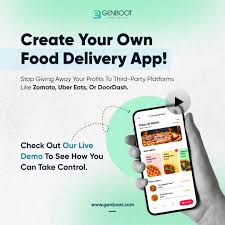Building the Future of Food: A Guide to Food App Development
In today’s fast-paced world, food app development is more than just a trend; it’s a necessity. As people increasingly rely on technology for their daily needs, food delivery, meal planning, and restaurant discovery apps are becoming essential tools for consumers and businesses alike. If you’re considering developing a food app, this guide will walk you through the key steps and considerations to help you create a successful product.
1. Define Your App’s Purpose
Before diving into development, clearly define the purpose of your app. Here are a few common types of food apps:
- Food Delivery Apps: Facilitate the delivery of meals from restaurants to consumers.
- Recipe Apps: Provide users with a collection of recipes, meal ideas, and cooking tips.
- Restaurant Discovery Apps: Help users find nearby restaurants, read reviews, and make reservations.
- Meal Planning Apps: Assist users in planning their meals, managing grocery lists, and tracking nutritional information.
Understanding your target audience and their needs is crucial for shaping your app’s features and functionality.
2. Research the Market
Conduct thorough market research to identify existing competitors, industry trends, and user preferences. Analyze popular apps like Uber Eats, DoorDash, or Yummly to understand what works and what doesn’t. Look for gaps in the market where your app can stand out—this could be in terms of unique features, user experience, or niche offerings.
3. Design an Intuitive User Experience (UX)
User experience is key in food app development. An intuitive design can make or break your app’s success. Focus on:
- User-Friendly Navigation: Ensure users can easily find what they’re looking for without confusion.
- Attractive UI Design: Use visually appealing elements that resonate with your target audience.
- Personalization: Offer features like customized meal plans or tailored restaurant recommendations based on user preferences.
Consider creating wireframes and prototypes to visualize your app’s layout and flow before moving on to development.
4. Choose the Right Technology Stack
Selecting the right technology stack is critical to your app’s performance. Consider the following:
- Platform: Decide if you want to develop for iOS, Android, or both. Each platform has its own development requirements.
- Backend Development: Choose a reliable backend framework that can handle data management, user authentication, and API integrations.
- Database: Select a database that suits your needs, whether it’s SQL or NoSQL, based on the volume and type of data you expect to handle.
5. Develop Key Features
The success of your food app will largely depend on the features you incorporate. Some must-have features include:
- User Registration and Profiles: Allow users to create accounts and manage their preferences.
- Search and Filters: Enable users to search for meals, restaurants, or recipes and filter results based on various criteria (cuisine type, dietary restrictions, etc.).
- Order Management: For delivery apps, provide a seamless order placement and tracking system.
- Payment Integration: Ensure secure payment processing with multiple payment options.
- Reviews and Ratings: Allow users to leave feedback on restaurants or recipes to foster community engagement.
6. Test Rigorously
Testing is a critical phase in app development. Conduct various types of testing, including:
- Functional Testing: Ensure all features work as intended.
- Usability Testing: Gather feedback from real users to identify any usability issues.
- Performance Testing: Check how your app performs under different conditions (e.g., heavy traffic, slow internet).
7. Launch and Market Your App
Once your app is ready, it’s time to launch! But launching is just the beginning. Develop a marketing strategy to attract users:
- Social Media Promotion: Leverage platforms like Instagram, Facebook, and TikTok to showcase your app.
- Influencer Collaborations: Partner with food bloggers or influencers to reach a wider audience.
- SEO Optimization: Optimize your app’s listing in app stores to improve visibility.
8. Gather Feedback and Iterate
Post-launch, gather user feedback and monitor app performance. Use analytics tools to track user behavior and identify areas for improvement. Regular updates and enhancements based on user input will help you retain users and grow your app’s popularity.
Conclusion
Food app development is a complex but rewarding journey. By understanding your target audience, conducting thorough research, and focusing on user experience, you can create an app that not only meets the needs of consumers but also stands out in a competitive market. Remember, the key to long-term success lies in continuous improvement and adaptation to evolving user preferences. Happy coding, and may your food app flourish!











